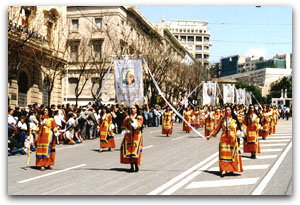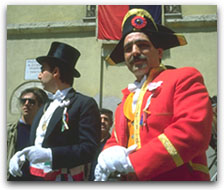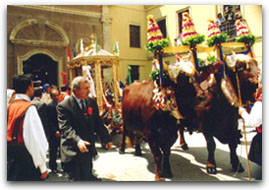 |
|
The "traccas" are followed by
different groups of people wearing the traditional costumes of their villages. They walk in
procession, saying or singing the traditional prayers that form part of the religious heritage of
the island, creating a very evocative atmosphere. Among the most eye catching costumes are
the orange coloured costumes from Desulo, the austere black dresses worn by the beautiful
and very tall girls from Tempio, the traditional gold jewellery on the waistcoats of the costumes
from Quartu and the barefooted fishermen from Cabras.
|
The horsemen are the most
spectacular part of the festival. They follow the people in their traditional costumes. The first
horsemen come from the Campidano region followed by the militia wearing red jackets. The
militia are the armed escort for the statue of the Saint and in ancient times they used to protect
the procession from the bandit raids which were frequent along the coastline. The procession
winds its way along the streets of the old part of Cagliari. These streets are lined by huge
crowds.
|
|
 |
 |
|
At midday sharp, the Saint leaves
his church in Stampace inside a seventeenth-century gold plated coach drawn by a pair of huge
oxen. The coach is preceded by the "Guardiania", in black top hats and tails. These are a group
of brothers from the confraternity of Sant'Efisio that escort the statue of the saint along the city
streets. Then follows the AlterNos (who represents the mayor). He is escorted by two
mace-bearers (from the municipality of Cagliari) in formal dress and by two lines of brothers
and sisters in penitential dress.
|
|